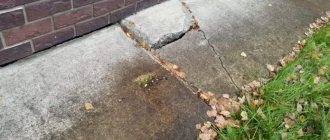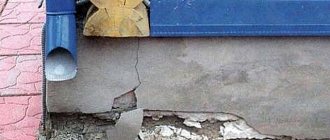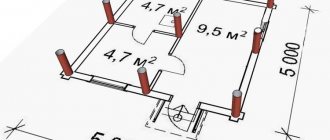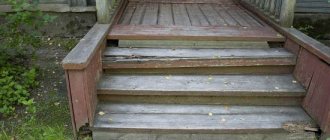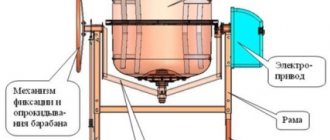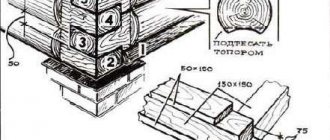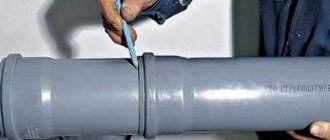Strip foundation is the main and most common type of supporting structure.
It is universal and resistant to most adverse influences, and has an optimal ratio of load-bearing capacity to its own weight.
Simplicity and reliability make the tape suitable for construction on almost any soil, capable of supporting buildings of large and small sizes and heights.
The design of the base is worked out to the smallest detail, but difficult or changing operating conditions significantly increase the degree of belt wear.
If there are signs of destruction or damage to the foundation, immediate repairs are required.
Service life of strip foundation
The service life of the belt depends on its size, type of construction, operating conditions and other factors.
But first of all, the duration of operation is affected by the material from which the foundation is composed:
- Monolithic concrete - up to 150 years.
- Prefabricated foundations made of piece materials (brick, etc.) - 30-50 years.
- Prefabricated foundations made of FBS (reinforced concrete foundation blocks) - 50-75 years.
The advantage of concrete strips is due to the monolithic structure , the absence of seams, joints and other weak points.
Crystallization of concrete continues for approximately half of its service life, after which a long stage of destruction of the material begins.
Prefabricated types of tape have a shorter service life due to the destruction of the material and the large number of joints.
Ground movements widen the cracks into which moisture penetrates. It freezes, expands and begins to tear the tape from the inside.
Despite all the effectiveness of modern waterproofing materials, it is impossible to ensure that all elements remain motionless relative to each other and that there are no cracks.
Reinforcement or connecting blocks to each other in this case also does not provide sufficient effect, which significantly reduces service life .
IMPORTANT!
Competent design and adherence to construction technology allows you to increase the service life of the foundation to maximum values.
Causes and types of foundation destruction
Identification of the reasons leading to the destruction of a reinforced concrete or brick foundation under an existing house largely determines the choice of technology for restoration and repair of the underground part of the structure. The main factors are:
- excessive increase in load on the foundation resulting from the construction of an additional floor;
- soil movement due to freezing;
- violation of the waterproofing of the basement of the house;
- accidents on connected underground communications;
- high groundwater level.
Seasonal increase in groundwater is the most common cause of gradual destruction of the foundation, manifested in the form of vertical cracks and breaks in the height of the base. In this case, you will need to install a bypass drainage system around the entire perimeter of the house. Another reason may be the filling of a recently constructed foundation with frozen soil. During cyclic thawing and freezing, its characteristic heaving occurs, which exerts a certain pressure on the surface of the foundation wall. To eliminate this phenomenon, you should select and replace the heaving soil, after filling the gaps with concrete mortar.
The reason for the delamination of the brick foundation masonry is its insufficient strength due to the lack of reinforcing bandage in it or due to the construction of an additional storey superstructure of the old house. The most effective method of eliminating the defect, in this case, is to redistribute the load on the foundation by installing remote beams and increasing its supporting area.
Frequent accidents on nearby underground utilities lead to a type of foundation destruction such as concrete leaching, caused by constant exposure to alkaline or salt water. Removing the aggressive environment from your home is a rather problematic task, but it can be solved. To do this, the soil around the foundation is removed in separate parts, after which the concrete surface is thoroughly cleaned, and the affected areas are filled with cement mortar. Brickwork is erected parallel to the foundation, insulated from the old foundation of the house with roofing felt. The brick is impregnated with polymer-bitumen mastic and coated with greasy clay. The final stage of work involves installing a drainage system around the foundation in order to lower the level of aggressive water.
How do you know if repairs are needed?
The need to repair the foundation is quite easy to detect visually . For an experienced person, this is not difficult, since all evidence of a problem appears quite clearly and is visible to the naked eye.
Signs of deformation or destruction of the tape:
- Subsidence of the entire house or individual sections, expressed in immersion in the ground or tilting of the building.
- The appearance of obvious cracks in the walls or visible part of the foundation (basement).
- Peeling of plaster, paint, distortion of facade panels.
- Window and door openings are skewed, causing the sashes to close poorly.
If the house has a basement , you can go down there and carefully examine the surface of the walls to detect emerging problems. The underground part of the house structure suffers first and traces of deformation are most noticeable here.
If there is no basement, you should walk around the perimeter of the house and assess the condition of the basement. If the house is finished with siding , you should try to detect distortions or convex places on the panels, indicating a violation of the geometry of the planes.
Causes of destruction of the LF
Defects in the foundation structure can occur under the influence of various factors .
One of the most common reasons is errors made at the design and construction stage of the building. Due to incorrectly calculated foundation depth, its width, the type of concrete used and the size of the reinforcing reinforcement, the structure may not withstand the working load and will begin to collapse.
The climatic conditions also affect the durability of the strip base:
- Heavy precipitation.
- Frequent temperature changes.
- Increasing groundwater levels.
The negative impact of rain and melt water must be compensated by the drainage system. If the drainage circuit is not designed correctly, the foundation will deteriorate faster due to the penetration of large amounts of moisture into the soil near the base of the building.
Building subsidence is also possible due to insufficient soil density . If geodetic measurements were not taken before building the house (or were carried out with insufficient accuracy), the calculated characteristics of the foundation will be incorrect.
The load will be unevenly distributed over the soil, which is why the house may sag in the most loaded areas of the concrete foundation.
Causes of destruction
There can be many reasons for deformation or damage to the tape:
- The presence of defects or errors in the project.
- Changes in groundwater levels, errors in geological exploration data or the consequences of man-made intervention.
- Frost heaving loads that are uneven and sharply changing in nature.
- Use of unsuitable or low-quality building materials.
- Construction of additional building elements that increase the load on the foundation.
- Formation of voids or gullies under the tape.
In most cases, problems arise in complex ways because they are closely related to each other.
The main source of damage is groundwater that changes its level, suddenly rises or disappears due to complex seasonal processes in the soil layers.
An increase in the weight of the house or the addition of additional rooms, which changes the balance of loads and redistributes the forces applied to the belt, also has a significant impact.
Determining the causes of foundation failure
To accurately determine what causes deformation of the fundamental foundation, it is recommended to use the services of specialists from a construction laboratory. But in this case, you should understand that their work will be quite expensive. Therefore, private home craftsmen try to independently examine the structure using inexpensive and simple techniques.
Determining the causes of foundation failure
Method 1
It is necessary to determine whether the width of the crack changes or remains unchanged. If the result is positive, then the expansion rate and its cause are additionally established.
As an auxiliary material, gypsum or cement mortar is used, as well as a ready-made mixture for plaster. The main thing is that the composition is sufficiently fragile and adheres well to the surface.
Special beacons are made from the selected material. To do this, prepare a mixture according to the manufacturer's instructions and apply it to the crack. The length of the beacon should be about 10 cm; it should be placed approximately in the middle of the fault. On each crack you should make two markers, at the beginning and at the end, using a narrow spatula.
Before applying beacons, the foundation must be thoroughly cleaned to ensure good adhesion of the solution to the surface.
Each marker must be numbered, and a specially kept notebook indicates the date of application and the number of the beacon. In addition, you need to make a horizontal mark on the beacon using a spatula or a thin ruler.
Further actions require regular inspection, it is important to carry it out at a certain interval. If during the next inspection a cracked marker is found, then we can say with confidence that the crack in the foundation is expanding.
To determine the rate of expansion of the fault, at each inspection, measure its width and record the result in a notebook. By analyzing the results obtained, you can determine the possible outcome.
At the same time, observe the horizontal mark made. If, when the marker cracks, displacement of parts is detected, then it can be argued that the structure is settling.
Method 2
An event of this kind allows you to get more information about the collapsing foundation, but you will also have to put in a lot more effort.
For such a study, it is necessary to prepare special pits, which are a hole up to 1 meter long and deep to the base of the foundation. The width is determined individually for each case, the main thing is that the pit does not cause inconvenience during work. For a more complete inspection, it is recommended to make several holes near the foundation. If the walls of the pit begin to crumble, you can make a kind of formwork from unedged boards.
The holes are dug in those places where deformation and destruction are most obvious. The pits allow you to obtain the following information:
- The depth of the foundation and the material used for its construction. The last factor is important if another owner built the house.
- General condition of the fundamental basis.
- Quality of the waterproofing layer.
- Depth of groundwater.
After completing research activities, you can begin repair work.
Diagnosis of the problem
Diagnostic measures are carried out using complex devices or tools; long-term and detailed studies of the condition of the belt , its movement or displacement relative to the longitudinal or transverse axis are performed.
You can determine the condition yourself by visual inspection of the visible surface of the tape. If it is necessary to conduct a study in dynamics, then the following actions are performed:
Installation of beacons. A gypsum solution is used, a layer of which is applied to the surface of the tape in problematic or questionable areas . Usually the cracks that have arisen are examined. The dimensions of the beacon are in the range of 100-120 mm in length and 39-50 mm in width, with a thickness of 3-5 mm.
Several beacons are installed on the extreme sides of the cracks so that it is possible to track their development.
A line is drawn on the surface of the beacons using the edge of a trowel. After 3 weeks of exposure, the beacons are inspected and conclusions are drawn about the condition of the tape , whether further propagation of the crack occurs and at what speed.
If serious problems or noticeable changes in the size of cracks are detected, a drilling test is performed. In problem areas of the belt, soil is removed to a width of about 1 meter .
The exposed surface of the foundation will allow us to obtain the most complete information about the size and possible causes of the problem, and will make it possible to assume the further course of events.
Usually they dig several holes in order to study the condition of concrete, waterproofing, sand cushion, etc. as fully as possible.
NOTE!
The more information about the presence and degree of development of undesirable processes is collected, the more effective the measures to eliminate the problems that have arisen will be.
Methods for performing repair work
There are several technologies for restoring and restoring old strip foundations. The choice of a specific method depends on:
- Crack widths.
- The speed of their spread.
- Depth of house subsidence.
If the damage is minor and does not increase in size (which indicates final shrinkage of the foundation), it is enough to perform cosmetic repairs. To do this, cracks in the foundation and walls are sealed with a concrete mixture and, if necessary, covered with a layer of finishing material.
If the problem continues to worsen, partial or complete replacement of the strip foundation will be required. This need arises when cracks gradually increase , and the building sinks deeper into the ground or becomes severely warped.
This can be determined not only visually, but also with the help of special beacons. It is enough to stick several strips of paper or other inextensible materials onto each crack.
If the beacons tear over time, this indicates an increase in cracks.
Partial replacement of the base is carried out pointwise, in areas of subsidence . This is the easiest and cheapest way to restore the foundation. If there are too many defects and new damage constantly appears, a complete replacement of the supporting structure will be required.
If the building sank due to mistakes made during the construction of the previous foundation, they cannot be repeated when constructing a new foundation.
For example, if the foundation has collapsed under the influence of groundwater, the new structure should be installed at a greater depth, below the soil freezing level. Otherwise, the house will sag again soon after replacing the strip foundation.
Repair methods
Restoration of the tape can be carried out under various technological conditions. The choice of the most suitable option depends on the nature of the damage, the size and dynamic state of the crack .
The main requirement for the measures taken is efficiency and high quality results. All work should be carried out as carefully as possible, carefully monitoring compliance with the technology, not allowing any deviations and not skipping any stages of work.
Repairing the tape is a labor-intensive, responsible and complex task, which should be solved under the guidance of an experienced specialist, or you can entrust the repair to a team of professional builders.
Main causes of destruction
The choice of foundation restoration technology depends on the cause of the onset of deformation.
The most common reasons:
- Exceeding the permissible load after the construction of superstructures;
- Violation of waterproofing;
- High groundwater level;
- Ground movement due to freezing and thawing;
- Errors made during pouring (incorrectly chosen pouring depth, incorrect calculation of cement mixture ratios, etc.);
- Earthworks near the building.
Crack repair
Before starting work, you should determine the cause of the cracks.
Experts distinguish several types:
- Hairy . The vast majority of such cracks form when the plaster dries unevenly and does not create any problems for the tape.
- Horizontal . Such cracks appear during the operation of the tape. They are considered not dangerous.
- Shrinkage . These cracks indicate weak bearing capacity of the soil, poor compaction of the sand cushion or other problems. If they are found, it is necessary to inspect and take urgent measures to repair the foundation.
It must be taken into account that any cracks, even those that do not pose a danger to the foundation, must be carefully sealed. Sooner or later, water will penetrate into them and destroy the material from the inside, so measures should be taken in any case.
To correct minor flaws, two methods are used:
- Sealing cracks with cement mortar . You can use ready-made mixtures that are purchased in the store. The solution is applied to the surface and rubbed in for maximum penetration inside. If the crack size is too small, you can widen it with a trowel or chisel.
- Pouring with epoxy resin . This method is good because the resin has high fluidity and is capable of filling large cracks. Before filling the crack, you should prepare it and be sure to dry it with a construction or household hair dryer. The resin will not stick to a wet surface, so before applying you need to wait about half an hour to check the quality of drying.
Shrinkage cracks cannot be repaired by simple sealing, since there will be no effect in this case.
More radical methods must be used.
House foundation repair
Cosmetic repairs to the foundation begin with digging it up. Moreover, if the house is located on a sloping area, repair work begins from elevated areas to prevent it from sliding. Next, the following repair work is performed:
- Clean off the damaged layer, wash, dry and prime.
- Afterwards, using dowels, a reinforcing mesh is attached to the foundation and the repair work itself is carried out - applying a plaster layer. The first plastering is called ironing - a two-centimeter layer of mortar is applied from equal parts of sand and cement. Allow 24 hours for hardening and then apply a standard plaster mortar using a high grade of cement in a cement to sand ratio of 1:4.
- At the final stage, they are coated with waterproofing mastic, although for greater strength, liquid waterproofing can be added to the primary layer of plaster. This will serve as additional protection for the foundation from aggressive underground and surface waters.
These works are simple, not too expensive, and can be done with your own hands. At the same time, it is important not to waste time in order to avoid serious damage and huge costs for carrying out major repairs with the help of construction specialists.
Foundation replacement
Foundation replacement can be complete or partial. The latter is more common due to the ability to do it yourself and its affordable cost. In this case, only damaged areas of the foundation are replaced.
To replace the entire foundation, heavy construction equipment will be required to lift the entire house. Nevertheless, some people do such work on their own, dividing them into sections no more than 2 m long. The essence of the method is as follows:
- First, beacons are installed on the walls of the house to prevent deformation of the walls when the house is raised.
- Then the foundation is unloaded and the load-bearing properties of the building are transferred to temporary supports.
- They expose the foundation, install spacers from boards to strengthen the walls of the dug trench, clean the foundation, wash, dry and prime.
- Sew the old foundation to the new one using cement mortar and reinforcing bars.
- The foundation is poured with concrete mortar, left to dry completely, and only after that proceed to work on the next section.
Video: raising a house and replacing the foundation
Leveling the foundation
Foundation leveling may be required in many cases. Now we are not talking about leveling the foundation during construction. Everything is clear here - clearly at the construction level. No errors are allowed. But what to do if the finished house has an uneven settlement or tilt. In this case, you will need to level the base (the above-ground part of the foundation):
- Beacons are installed on the walls of the house, as when replacing the foundation.
- Raise the part of the house where leveling is required and install temporary supports.
- Treat the horizontal surface of the base (clean, wash, dry and prime).
- Apply a concrete screed of the required height. It is made multi-layered - if the difference is about 10 cm, then each layer is leveled. A waterproofing layer is applied.
To level the foundation, you need to raise the sagging section of the wall, restore the integrity and strength of the foundation, and, if necessary, increase the bearing capacity of the soil
If the foundation is columnar, replace several (or all) piles or make an armored belt in the form of a continuous reinforced concrete strip. Asbestos pipes, which are reinforced and filled with liquid cement mortar, are best suited for piles.
Brick foundation repair
We wrote above about repairing a brick foundation. There is another inexpensive method - cementation - filling the resulting voids inside the masonry. To cement a brick foundation, you need:
- Provide access to the foundation and clean it well.
- In places with weakened masonry, make holes and use a construction syringe to pump liquid concrete (cement-sand mortar in proportions from 1:1 to 1:2) into them until the voids are completely filled.
- In houses with a basement, such work can be done from the inside.
Screw foundation repair
The foundation made of screw piles is durable and unpretentious, so it rarely needs repairs. More often, there are cases when it is necessary to strengthen such a foundation with pipes or channels in connection with the superstructure of a building, for example. It happens less often that the piles still need to be replaced because their ability to support the weight of the house has decreased. In both cases they do the same:
- Dismantle the outer cladding of the base.
- They lift the building with jacks and carry out the necessary work - they strengthen the existing piles (encircle them with a metal belt), add new piles, or change old ones.
- When the welding work is completed, all metal elements are treated with an anti-corrosion compound and the building is carefully lowered onto a reinforced and updated base.
- Restore the basement cladding.
Video: mistakes when tying screw piles
Raising the house and pouring the foundation
When lifting a house, the most important thing is not to drop it. You can raise the building clockwise or counterclockwise. Practice shows that to lift a structure weighing up to 7 tons, one jack with a ten-ton force is enough. To raise a house yourself, you need to do the following:
- To begin with, bulky things are removed from the house (you can even disassemble the floors) to lighten the weight.
- Then they begin to work with a jack, raising one side no more than 5 cm at a time. They act in a circle.
- When raised slightly, thick wooden blocks are placed in the form of temporary supports.
Builders advise in any case to use metal blocks, which will be much more reliable. Or at least put them on the lower levels.
It is not recommended to raise the house above 35–40 cm on your own. If you need to raise a house higher, raise a stone house, move a building, then such work should be entrusted to professionals who in their work use expensive hydraulic equipment, a lot of fasteners, install a double metal frame, I-beams, and use welding. Of course, the prices for such work are appropriate.
Video: how to raise a house yourself
Before lifting your house, you need to think about jack supports. To do this, holes are drilled at an angle along the perimeter of the building every meter, reinforcement is inserted into them and filled with concrete. The result is mini-piles, which will first serve as a support for the jacks, and then become part of the foundation.
- After the house is raised to the required height, a trench is dug along its entire length.
- They clean out the old foundation and make formwork.
- The ends of the reinforcement protruding from the holes are bent and welded (this creates a reinforced frame around the perimeter of the house).
- Then they fill it with concrete, and after it dries, the house is lowered onto the restored foundation.
How to strengthen the foundation
Before strengthening, it is necessary to eliminate the causes causing deformation and destruction of the foundation. Perhaps this will be enough and no strengthening work will be needed. The main reasons are:
- Increased soil moisture. It is necessary to pay attention to the blind area around the foundation and drain the foundation.
- Violation of construction technology.
In this case, the foundation should be strengthened according to the appropriate scheme. Failure to comply with construction technology, in particular insufficient deepening of the foundation, leads to the fact that individual parts of the foundation, under the influence of frost heaving forces, are squeezed upward from the soil, violating the geometry of the entire structure - The plot of land is characterized by heterogeneous soil, which leads to deformation of the foundations of existing buildings. For efficiency, a set of measures is used - replacing unstable areas of soil with sand and crushed stone, drainage, insulation, waterproofing, additional thermal insulation of heaving soil layers under and next to the foundation, strengthening.
Repair of the foundation of a wooden house
Wooden buildings are usually lightweight, so they can be lifted without much difficulty to repair or replace the foundation. Which is what they often do. You just need to follow some rules:
- Digging holes is desirable. Trenches are dug either around the perimeter of the entire building, or only in areas of elevation. This will greatly simplify access to the foundation for repairs. And also by filling the pits with water, you can determine the level of groundwater and the degree of its aggressiveness.
- Installation of the jack is done only in reliable, undamaged places.
- To be on the safe side, in case the jack cannot bear the load, it is advisable to drive wooden wedges every 15–20 cm between the house itself and the foundation pad.
- The old foundation of the house must be dismantled down to the ground. It is acceptable, if the budget for repairs is limited, to perform only partial disassembly and repair of heavily damaged areas. But you should not abuse this - such repairs will not bring much savings, and the quality of the updated foundation will suffer.
When lifting wooden buildings, the maximum load falls on the lower crowns. To prevent sagging, you need to tighten them with a steel hoop.
How to raise a subsiding foundation
Lifting the subsiding tape will stop the development of cracks and prevent the destruction of the walls of the house. To carry out the work, it is necessary to dig out the entire problematic section of the belt (usually a corner or half of the foundation is cleared) from the ground and secure the trench slope with shields.
Then you can apply two methods:
- Create overstressed concrete clips that take the load on themselves and lift the old tape relative to its previous position.
- Use special chemical reagents that increase their volume and lift the tape. Injections are made into the underlying sand layer, after which the cushion is compacted and expanded as much as possible, raising the tape.
The first method is considered simpler and more reliable, while the second option is complex and requires accurate calculations, the participation of special equipment and a team of professionals.
In any case, the decision must be made only after consultation with representatives of construction companies.
How to build up
The extension has two directions - width or height. To repair the tape, an increase in width is usually used, which fills cracks and strengthens the base.
The work is carried out in stages:
- The problem area of the tape is cleared from the soil.
- The surface is thoroughly cleaned of the waterproofing layer, dried, and notches are applied.
- In the outer area, holes are drilled into which reinforcing bars are inserted. A reinforcement cage is welded to them for an additional layer of concrete.
- Formwork is installed and concrete is poured.
- After hardening, the surface is carefully waterproofed and finishing work is carried out.
Main causes of damage to foundations
Conventionally, all factors that lead to cracks in the foundation can be divided into the following groups:
- Natural. This is the action of soil swelling, the impact of surface and groundwater, as well as seasonal freezing.
- Anthropogenic. Through exposure to groundwater contaminated with pesticides, acids and alkalis. There is also the possibility of exposure to acid rain through an improperly installed drainage system.
- Technological. These include incorrect calculation of the permissible load on the foundation, selection of the wrong type of cement and poor connection of reinforcement. Also, the human factor cannot be excluded, especially when calculating the load on individual supports.
Therefore, to make it easier to select the optimal technology for repairing the base and supports, all possible reasons are grouped into the following main groups:
- Unauthorized increase in loads on the foundation;
- Incorrect foundation calculation;
- Deformation of masonry due to violation of the waterproofing layer;
- Displacement of supports due to seasonal soil movements;
- Damage to the base and water ingress;
- Movement of structures due to improper fixation of supports on quicksands;
- Accidents on utilities;
- Incorrect proportions for concrete or poor building materials were used.
If there is a violation of the waterproofing layer, then eliminating the cause will not be difficult. To do this, you just need to punch a hole a couple of bricks deep in the base, level the surface and lay out a couple of waterproofing balls. The remaining reasons are not so easy to eliminate; you will have to spend a lot of time and money.
How to replace a pile foundation with a strip foundation
Most often, the tape is replaced or supplemented with piles.
If there is a need for reverse actions ( for example, the piles are destroyed or it is necessary to increase the load-bearing capacity of the foundation ), then a complex set of works will have to be carried out to install the house on temporary load-bearing structures, create formwork and armored belts and fill the tape.
Metal beams that can support its weight are placed under the lower frame of the house . Using powerful jacks, the building is lifted and hung horizontally.
Then formwork and an armored belt are installed under the load-bearing walls, which must be mechanically connected to the piles.
If you no longer intend to use them, you can skip this step. Then concrete is poured into the formwork, evenly distributing it along the entire length .
IMPORTANT!
After hardening (no earlier than 10 days), the formwork is removed, but the resulting tape must be kept for up to 1 month before it becomes possible to release the jacks and load the foundation.
Major renovation
Severe destruction of the foundation of the building requires its complete replacement. The methods depend on the building material.
Overhaul of the foundation under the log house is carried out in the following ways:
Replacement with moving the frame. The method is used for log houses weighing no more than 4 tons. For example, a 4x4 pine log house weighs 3.5 tons. You can raise such a house without using special equipment. You will need 2 jacks and 2 channels. Next to the destroyed one, a new foundation is poured with a base 20 cm lower than the old one. The log house is lifted with a jack and moved along the channel to the new foundation. The structure is fixed.
Replacement with house lifting. The method is used if the log house is heavy or there is no free area for movement. Under the log house, two holes are punched on one side and channels are inserted. Jacks are installed under the beams, the frame is raised 20 cm and supports are installed. Then the same procedure is carried out on the other side. Formwork is installed around the perimeter of the building and concrete is poured. Sometimes the only repair option is to completely destroy the foundation and pour a new one.
Partial repair with reinforcement. If the foundation is damaged in some places, jointing is performed with reinforcement. The corner of the frame is raised, jointed with M12 reinforcement and filled with cement mortar.
The frame can be lowered or moved for any repair option no earlier than three weeks, when the concrete has gained strength.


